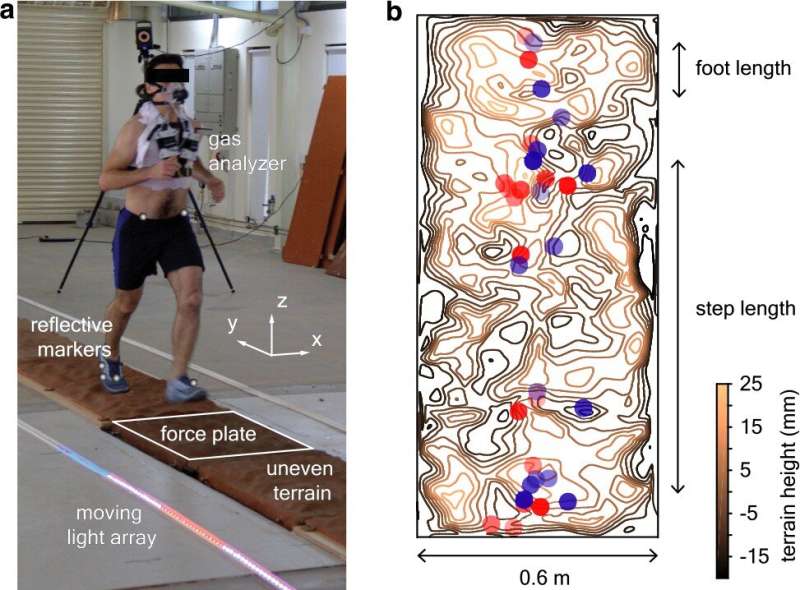
If you go running over a trail in the woods or a grassy field, there are countless bumps and dips in the terrain, each with the potential to trip you up. But typically, runners manage just fine. It’s a remarkable physical feat that we tend to take for granted. A team of researchers set out to better understand it.
With a specially made running track and mathematical modeling, the lab of Madhusudhan Venkadesan found that when running on uneven terrain, humans mostly rely on the body’s mechanical response for stability rather than consciously plot out their footsteps to find level ground. Further, they found that the runners were just as efficient in their movements and physical exertion as when running on flat ground. The results are published in eLife.
Even without occasional hazards like steep drops, runners must contend with gentler, but still uneven, ground that can be destabilizing. So why aren’t trails typically littered with toppled runners? One possibility is that visual cues allow runners to carefully observe the land to step on mostly level areas. On the other hand, running played a huge role in human evolution, particularly in how it benefited humans in hunting. That means sight cannot be devoted solely to find areas to step on; it’s also needed to watch out for the prey, trees or other obstacles to avoid, and decide which path to take.
“Imagine running and constantly looking at the ground right in front of you to decide where to place the your step,” said Venkadesan, associate professor of mechanical engineering and materials science. “You can’t be devoting all your attention just to that problem, because your vision is needed for many things.”
Because an actual trail in the woods doesn’t have the controlled conditions necessary for a scientific study, Venkadesan commissioned the construction of an uneven trackway from a company that specializes in climbing walls. The researchers heuristically designed different levels of unevenness of the terrain to mimic the kind of uneven trail that outdoor runners often encounter. They outfitted the 70-foot-long, 3-foot-wide track with technology that can track and measure where on the terrain the runners’ feet were landing. This included a sensor in one area part of the track to measure the forces experienced by the foot.
“With this, we could measure in a few of those steps how forces are felt by the runner,” he said. “In addition, we measured key landmarks on the body using 3D-motion capture. So we could ask, what does the center of mass movement look like? Are they meandering around and trying to find a path, or just going straight down the middle?”
Nihav Dhawale, a recently graduated Ph.D. student from Venkadesan’s lab, developed a mathematical model of a runner who would try to find the most level path through the uneven bumps, while still matching the runner’s step length and width. This model would ask whether there’s a feasible path through the trackway that can minimize the unevenness, and thus ask whether the real runners find that path.
As it turns out, the runners weren’t choosy about where they put their feet.
“What we found was people appear to land their feet wherever they like,” Venkadesan said. “They don’t seem to care about the unevenness.”
So, in that case, how do runners manage to stay upright? The researchers found that, rather than trying to find specific level areas, the runners minimized the horizontal forces experienced when they land, and therefore used their body’s intrinsic mechanics to reduce the destabilizing influence of the terrain’s unevenness. The mathematical modeling showed that the runners kept their legs as compliant as they could, and doing so allowed them to minimize the horizontal forces when their feet touched down (that is, the sliding, scuffing forces upon impact). The same authors had predicted in an older paper that low horizontal forces would drastically mitigate the instability associated with running on uneven terrain. As a result, the runner has several steps to make small corrections to regain full stability.
“The corrective action doesn’t have to occur in milliseconds or within a single step,” Venkadesan said. “It could occur over a few steps, and that’s adequate to maintain stability. So in a sense, we are letting the mechanical response of our body buy the brain extra time to control stability.”
More information:
Nihav Dhawale et al, How human runners regulate footsteps on uneven terrain, eLife (2023). DOI: 10.7554/eLife.67177
Journal information:
eLife
Source: Read Full Article





